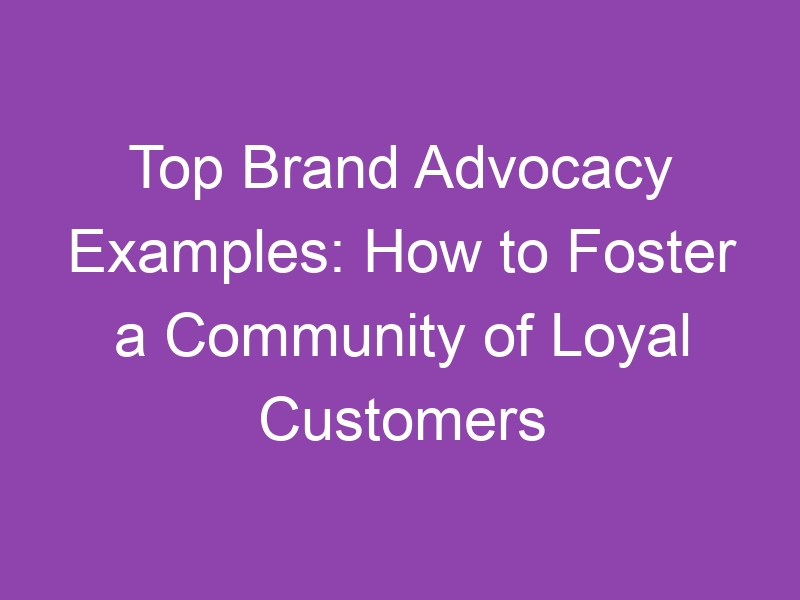Content Outline
- Introduction
- A. Definition of brand advocacy program
- B. Importance of onboarding participants
- Benefits of onboarding participants into the brand advocacy program
- Best practices for onboarding participants
- A. Communication strategies
- B. Providing resources and support
- C. Setting expectations
- Common mistakes to avoid when onboarding participants
- Measuring success
- A. Key performance indicators
- B. Tracking progress
- Conclusion
Introduction
Once you’ve onboarded a participant into the brand advocacy program, the next step is to ensure that they are engaged and motivated to continue their brand advocacy efforts. In this section, we’ll explore the key factors that contribute to participant engagement and motivation, and how they can be leveraged to maximize program success.
- Clear Expectations: One of the most important factors in participant engagement is setting clear expectations from the outset. Make sure that participants understand the goals of the program, their role in the program, and what is expected of them in terms of participation and brand advocacy efforts.
- Recognition and Rewards: Providing participants with recognition and rewards for their efforts can be a powerful motivator. Consider offering incentives such as discounts, exclusive access to products or events, or even cash rewards for top performers.
- Communication: Regular communication with program participants is essential for keeping them engaged and motivated. Provide updates on program progress, share success stories, and offer tips and resources to help participants improve their brand advocacy efforts.
- Training and Support: Providing participants with the tools and resources they need to succeed is key to keeping them engaged and motivated. Offer training sessions, webinars, and other resources to help participants improve their brand advocacy skills and knowledge.
By leveraging these key factors, you can create a brand advocacy program that is engaging, motivating, and ultimately successful. Stay tuned for the next section where we’ll dive deeper into the importance of clear expectations in brand advocacy programs.
Introduction – A. Definition of brand advocacy program
A brand advocacy program is a marketing initiative designed to leverage the power of satisfied customers to promote a brand. This approach involves identifying, nurturing, and incentivizing loyal customers to share positive experiences and recommendations about a brand with their personal and professional networks. Once you’ve onboarded a participant into the brand advocacy program, they become a valuable asset for promoting your brand and driving customer acquisition and retention.
Key Factors of a Successful Brand Advocacy Program
- Clear Goals: A successful brand advocacy program should have clear, measurable goals that align with your overall marketing strategy. This can include increasing brand awareness, driving website traffic, or generating sales leads.
- Targeted Audience: Identifying the right audience for your brand advocacy program is crucial for its success. You need to consider who your ideal customer is and where they are likely to be found.
- Incentivization: Providing incentives for participants to share positive experiences about your brand is a key component of a successful brand advocacy program. This can include rewards such as discounts, exclusive access to events or products, or even cash incentives.
- Engagement: Engaging with your brand advocates is essential for maintaining their interest and enthusiasm. This can include providing them with regular updates about new products, exclusive offers, or other relevant information.
- Measurement: Measuring the success of your brand advocacy program is critical for optimizing its effectiveness. This can include tracking website traffic, social media engagement, or sales leads generated by your brand advocates.
By implementing a successful brand advocacy program, you can tap into the power of your satisfied customers to promote your brand and drive growth. To learn more about how to create an effective brand advocacy program, check out this Forbes article.
Introduction – B. Importance of onboarding participants
Brand advocacy programs are an essential part of any marketing strategy. Once you’ve onboarded a participant into the brand advocacy program, you have a dedicated and passionate advocate to promote your brand to their network. However, the onboarding process is crucial to ensure that these participants are well equipped to become effective brand advocates.
The benefits of effective onboarding
- Increased engagement: A well-designed onboarding program can increase engagement levels among brand advocates, leading to more effective promotion of the brand.
- Improved retention: Participants who receive a comprehensive onboarding experience are more likely to remain engaged in the program and continue advocating for the brand.
- Higher quality advocacy: Effective onboarding ensures that participants have a clear understanding of the brand and its values, leading to more authentic and effective advocacy.
The costs of poor onboarding
On the other hand, poor onboarding can have significant negative consequences:
- Low engagement: Poorly onboarded participants may not fully understand the program or their role in it, leading to low engagement levels.
- Decreased retention: Participants who are not properly onboarded may become frustrated or disillusioned with the program, leading to high dropout rates.
- Ineffective advocacy: If participants don’t fully understand the brand and its values, their advocacy efforts may come across as inauthentic or ineffective.
Best practices for onboarding participants
To ensure that your brand advocacy program is successful, it’s important to follow these best practices for onboarding participants:
- Provide clear instructions: Make sure participants understand what’s expected of them and how they can participate.
- Offer training: Provide training on topics like the brand’s values, voice, and messaging to ensure that participants understand how to advocate for the brand effectively.
- Communicate regularly: Keep participants informed about program updates, new products or services, and other relevant information.
- Provide incentives: Offer rewards and recognition for active participation to keep participants engaged and motivated.
Effective onboarding is essential for the success of any brand advocacy program. By following best practices and investing in a comprehensive onboarding experience, you can ensure that your brand advocates are well equipped to promote your brand to their network and drive business growth.
Sources:
- Salesforce: Why Onboarding is the Key to Brand Advocacy Program Success
- Campaign Monitor: The Ultimate Guide to Brand Advocacy
- Social Media Examiner: How to Create a Brand Advocacy Program to Impact Your Business
Benefits of Onboarding Participants into the Brand Advocacy Program
Onboarding participants into the brand advocacy program has numerous benefits for businesses. Once you’ve onboarded a participant into the brand advocacy program, you can expect:
- Increase in brand awareness: Advocates can help increase the visibility of your brand by sharing their positive experiences with their friends and family. According to a study by Nielsen, 92% of consumers trust recommendations from friends and family over any other type of advertising.
- Higher customer engagement: Brand advocates are more likely to engage with your brand, share their feedback, and participate in surveys and user-generated content. A study by Zuberance found that advocates are 50% more likely to influence a purchase.
- Cost-effective marketing: Brand advocacy is a cost-effective way to market your brand. Advocates are willing to promote your brand for free, which reduces the cost of advertising and customer acquisition. According to a study by Hubspot, businesses that prioritize customer advocacy programs generate 2x higher revenue growth compared to those that don’t.
- Improved customer loyalty: Participants in brand advocacy programs are more likely to become loyal customers. They feel a stronger connection to your brand and are more likely to stick with you in the long run. In fact, a study by Yotpo found that 66% of consumers say they are more loyal to brands that engage with them on social media.
In conclusion, onboarding participants into the brand advocacy program is crucial for businesses looking to increase brand awareness, customer engagement, and loyalty while reducing marketing costs. Once you’ve onboarded a participant into the brand advocacy program, you can expect to see significant benefits for your business.
Sources:
- Nielsen study on trust in advertising and brand messages
- Zuberance study on advocates’ influence
- Hubspot study on revenue growth with customer advocacy programs
- Yotpo study on loyalty program statistics
Best practices for onboarding participants
Onboarding participants into a brand advocacy program can be a challenging task, but with the right strategies in place, it can lead to long-term success. Here are some best practices to consider:
- Set clear expectations: From the start, let participants know what is expected of them in the brand advocacy program. This includes the type of content they will be creating, the frequency of their posts, and any guidelines they need to follow. This transparency will prevent confusion and set the tone for a successful partnership.
- Provide training: Even if participants are already familiar with the brand, they may not know how to effectively advocate for it. Providing training sessions or resources will ensure that they have the knowledge and skills needed to create high-quality content that resonates with their audience.
- Offer incentives: Incentives can motivate participants to stay engaged and committed to the brand advocacy program. This can include exclusive access to events, discounts on products or services, or even monetary compensation.
- Encourage communication: Regular communication between the brand and participants is essential. This includes providing feedback on content, answering questions, and addressing any concerns. Keeping an open line of communication will help build trust and strengthen the relationship between the brand and its advocates.
Once you’ve onboarded a participant into the brand advocacy program, it’s important to continue to nurture and support the relationship. By implementing these best practices, you can create a successful brand advocacy program that benefits both the brand and its participants.

Sources: HubSpot, Social Media Examiner
Best practices for onboarding participants – A. Communication strategies
Communication is key when onboarding participants into your brand advocacy program. Once you’ve onboarded a participant into the brand advocacy program, it’s important to keep them engaged and motivated to continue advocating for your brand. Here are some best practices for communication strategies:
- Utilize a welcome email: Within 24 hours of a participant signing up for your brand advocacy program, send them a welcome email. This email should include a thank you for signing up, an overview of the program, and any next steps they need to take.
- Provide clear instructions: Make sure participants understand what is expected of them. Clearly outline the program’s goals, the actions participants need to take, and the rewards they can earn. Consider creating a visual guide or video tutorial to help participants understand the program.
- Be consistent: Communication should be consistent and frequent. Consider sending regular updates on the program’s progress, new rewards, and any changes to the program. This helps keep participants engaged and motivated to continue advocating for your brand.
- Personalize communication: Use participants’ names in communication and tailor messages to their interests. This helps make participants feel valued and appreciated for their efforts.
- Offer support: Make sure participants have access to support if they have questions or need help. Provide an email address or phone number they can contact if they need assistance.
- Measure success: Track the success of your communication strategies to see what’s working and what’s not. Use analytics to determine open rates, click-through rates, and engagement rates. Use this information to refine your communication strategies and improve engagement.
Remember, effective communication is essential for onboarding participants into your brand advocacy program. By utilizing these best practices, you can keep participants engaged and motivated to continue advocating for your brand.
Sources: https://www.impactbnd.com/blog/brand-advocacy-programs, https://www.business2community.com/marketing/brand-advocacy-programs-5-best-practices-for-success-02353877
Best practices for onboarding participants – B. Providing resources and support
Once you’ve onboarded a participant into the brand advocacy program, it’s important to provide them with the resources and support they need to succeed. This not only helps them feel valued and supported, but it also increases the likelihood of their success as advocates for your brand.
1. Provide clear guidelines and expectations
- Make sure participants understand what is expected of them as brand advocates.
- Provide clear guidelines on what they can and cannot do when representing your brand.
- Set expectations for how often they should be participating in advocacy activities.
2. Offer training and education
- Provide participants with training on how to effectively promote your brand.
- Offer education on your brand’s values, mission, and goals so they can align their advocacy efforts accordingly.
- Consider offering ongoing education to keep participants up-to-date on your brand’s latest developments.
3. Provide ongoing support
- Offer support to participants as they navigate their role as brand advocates.
- Be available to answer questions and provide guidance when needed.
- Consider creating a community or forum where participants can connect with each other and share their experiences.
By providing clear guidelines and expectations, offering training and education, and providing ongoing support, you can set your brand advocates up for success. This not only benefits your brand, but also helps participants feel valued and supported in their role as brand advocates.
Sources:
https://www.impactbnd.com/blog/10-essential-steps-in-a-successful-employee-onboarding-process,
https://www.referralsaasquatch.com/advocate-onboarding-best-practices/
Best practices for onboarding participants – C. Setting expectations
Setting clear expectations for participants is essential to ensure that they understand their role in the brand advocacy program. Once you’ve onboarded a participant into the program, it’s important to communicate what is expected of them and what they can expect from the program. Here are some best practices for setting expectations:
- Be transparent: Provide participants with a clear understanding of what the program entails, how it works, and what they can expect to receive in exchange for their participation. Transparency builds trust and helps participants feel more invested in the program.
- Establish goals: Set clear goals for the program and communicate them to participants. This helps them understand what they are working towards and how their participation contributes to the overall success of the program.
- Define roles and responsibilities: Clearly define the roles and responsibilities of both the participants and the program organizers. This helps prevent misunderstandings and ensures that everyone is on the same page.
- Provide guidelines: Provide participants with guidelines for participation, such as how often they should share content, what kind of content is appropriate, and how to best engage with their audience. Guidelines help participants understand how to be effective advocates for the brand.
- Offer support: Offer participants support and resources to help them be successful in the program. This could include training, coaching, or access to a community of other program participants.
By setting clear expectations for participants, you can ensure that they understand their role in the program and are motivated to be effective advocates for the brand. For more information on onboarding participants into a brand advocacy program, check out this article from Social Media Examiner.
Common mistakes to avoid when onboarding participants
Onboarding participants into a brand advocacy program is a crucial step towards building a loyal customer base. However, there are several common mistakes that brands make during the onboarding process that can negatively impact the success of the program. Here are some mistakes to avoid:
- Not setting clear expectations: One of the most important aspects of onboarding is setting clear expectations with participants. If participants don’t know what’s expected of them, they’re less likely to engage with the program. Be sure to clearly communicate the goals of the program and what participants are expected to do once they’re onboarded.
- Not providing enough guidance: Participants may have questions or need guidance on how to participate in the program. It’s important to provide clear instructions and resources to help them navigate the program. Consider creating a comprehensive guide or FAQ section to address common questions.
- Not offering incentives: Incentives can be a powerful motivator for participants. Without incentives, participants may not be motivated to participate in the program. Consider offering rewards such as discounts, exclusive content, or early access to products.
- Not measuring success: It’s important to measure the success of the program to determine what’s working and what’s not. Without measuring success, it’s difficult to make informed decisions about the future of the program. Consider tracking metrics such as engagement rates, referral rates, and sales conversions.
Once you’ve onboarded a participant into the brand advocacy program, it’s important to continue to engage with them and provide ongoing support. By avoiding these common mistakes, you can increase the likelihood of success for your brand advocacy program.
Sources: Forbes, Single Grain
Measuring success in brand advocacy programs
Once you’ve onboarded a participant into the brand advocacy program, it’s essential to have a system in place to measure the success of your program. Here are some key factors to consider when measuring success:
- Engagement rate: One of the most important metrics to track is the engagement rate of your brand advocates. This can include metrics like social media shares, likes, comments, and clicks on links. A high engagement rate indicates that your brand advocates are actively promoting your brand to their networks.
- Conversion rate: Another important metric to track is the conversion rate of your brand advocacy program. This can include metrics like the number of new customers acquired and the revenue generated from brand advocate referrals. A high conversion rate indicates that your brand advocates are not only promoting your brand but also driving actual sales.
- Retention rate: It’s also important to track the retention rate of your brand advocates. This can include metrics like the percentage of brand advocates who continue to participate in the program, as well as their overall satisfaction with the program. A high retention rate indicates that your brand advocacy program is effective at keeping brand advocates engaged and motivated.
It’s important to keep in mind that there are tradeoffs involved in measuring success in brand advocacy programs. For example, focusing too heavily on metrics like conversion rate can lead to a program that prioritizes sales over building long-term relationships with brand advocates. On the other hand, focusing too much on engagement rate can lead to a program that lacks a clear ROI.
To strike the right balance, it’s important to take a holistic approach to measuring success in brand advocacy programs. By considering a variety of metrics and balancing short-term and long-term goals, you can build a program that not only drives sales but also builds a community of loyal brand advocates.
Sources: Forbes, TapInfluence
Measuring Success – A. Key Performance Indicators
Once you’ve onboarded a participant into the brand advocacy program, it’s important to measure the success of your efforts. Key Performance Indicators (KPIs) are essential in helping you track progress and identify areas for improvement.
1. Conversion Rates
One of the most important KPIs to monitor is conversion rates. How many participants are actually completing the tasks assigned to them? Are they converting at a higher rate than non-participants? This information can help you determine the effectiveness of your program and make changes accordingly.
2. Engagement Metrics
Engagement metrics such as likes, comments, and shares on social media can help you gauge the level of interest and participation in your program. It can also help you identify potential advocates who are highly engaged and may be good candidates for further involvement.
3. Referral Traffic
Tracking the amount of referral traffic your participants are generating can help you determine the effectiveness of your program in driving new traffic to your website or social media channels. It can also help you identify potential areas for improvement in your program.
4. Customer Lifetime Value
Customer Lifetime Value (CLV) is a metric that measures the total value a customer brings to your business over their lifetime. By tracking the CLV of participants in your brand advocacy program, you can determine the long-term value of your program and its impact on your bottom line.
Remember, measuring success is an ongoing process. Regularly monitoring your KPIs and making adjustments as needed can help ensure the long-term success of your brand advocacy program.
Sources:
- WordStream – Marketing KPIs: 18 Essential Metrics for Success
- Forbes – How to Measure the Success of Your Brand Advocacy Program
- Salesforce – Customer Lifetime Value
Measuring success – B. Tracking progress
Once you’ve onboarded a participant into the brand advocacy program, it’s important to track their progress and measure their success. This allows you to identify areas for improvement and make data-driven decisions to optimize the program.
Tracking progress with metrics
One way to track progress is through the use of metrics. These can include:
- Number of referrals generated
- Number of social media shares
- Number of clicks on shared links
- Number of purchases made through referrals
By tracking these metrics, you can see which participants are most successful and which areas of the program may need improvement. You can also use these metrics to set goals and benchmarks for participants to strive towards.
The tradeoffs of incentivizing success
While incentivizing success can be a powerful motivator for participants, it can also have its downsides. For example, participants may become solely focused on earning rewards rather than genuinely advocating for the brand. Additionally, incentivizing success can be costly and may not be sustainable in the long run.
To mitigate these tradeoffs, it’s important to strike a balance between incentivizing success and fostering genuine advocacy. One way to do this is by offering non-monetary rewards, such as exclusive access to events or early product releases.
Conclusion
Tracking progress and measuring success is crucial for optimizing a brand advocacy program. By using metrics and balancing incentives, you can create a program that fosters genuine advocacy and generates real results.
Sources: https://www.impactbnd.com/blog/brand-advocacy-program, https://www.influitive.com/blog/brand-advocacy-programs/
Conclusion
Once you’ve onboarded a participant into the brand advocacy program, it’s important to keep them engaged and motivated to continue advocating for your brand. One way to do this is by consistently providing them with valuable content and rewards for their efforts.
- Make sure to regularly communicate with your brand advocates through email newsletters or social media updates. This will keep them informed about new products, promotions, and other news related to your brand.
- Offer incentives such as exclusive discounts, early access to new products, or even cash rewards to show your appreciation for their advocacy efforts.
- Encourage your brand advocates to share their experiences with your brand on social media using hashtags and tagging your brand’s account.
Remember, brand advocacy is a long-term strategy that requires consistent effort and investment. However, the benefits of having a loyal group of brand advocates can greatly outweigh the costs.
According to a study by Yotpo, brand advocates are 50% more likely to influence a purchase than a regular customer, and they also have a 37% higher retention rate. Additionally, a study by MarketingCharts found that brand advocates spend 2x more on average than regular customers.
By investing in your brand advocacy program and keeping your advocates engaged, you can not only increase brand loyalty and retention, but also drive sales and revenue for your business.



